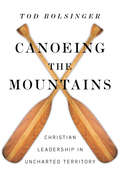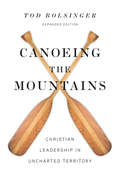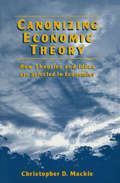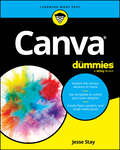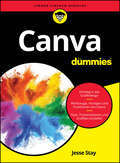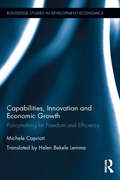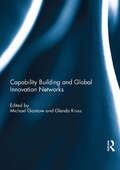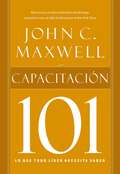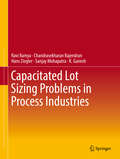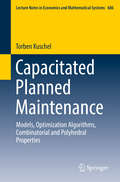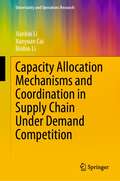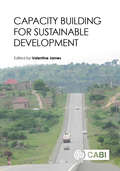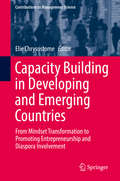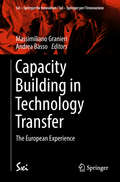- Table View
- List View
Canoeing the Mountains: Christian Leadership in Uncharted Territory
by Tod Bolsinger14th Annual Outreach Magazine Resource of the Year, LeadershipExplorers Lewis and Clark had to adapt. While they had prepared to find a waterway to the Pacific Ocean, instead they found themselves in the Rocky Mountains. You too may feel that you are leading in a cultural context you were not expecting. You may even feel that your training holds you back more often than it carries you along.Drawing from his extensive experience as a pastor and consultant, Tod Bolsinger brings decades of expertise in guiding churches and organizations through uncharted territory. He offers a combination of illuminating insights and practical tools to help you reimagine what effective leadership looks like in our rapidly changing world.If you’re going to scale the mountains of ministry, you need to leave behind canoes and find new navigational tools. Reading this book will set you on the right course to lead with confidence and courage.
Canoeing the Mountains: Christian Leadership in Uncharted Territory
by Tod Bolsinger14th Annual Outreach Magazine Resource of the Year, Leadership Explorers Lewis and Clark had to adapt. While they had prepared to find a waterway to the Pacific Ocean, instead they found themselves in the Rocky Mountains. You too may feel that you are leading in a cultural context you were not expecting. You may even feel that your training holds you back more often than it carries you along. Drawing from his extensive experience as a pastor and consultant, Tod Bolsinger brings decades of expertise in guiding churches and organizations through uncharted territory. He offers a combination of illuminating insights and practical tools to help you reimagine what effective leadership looks like in our rapidly changing world. If you're going to scale the mountains of ministry, you need to leave behind canoes and find new navigational tools. Now expanded with a study guide, this book will set you on the right course to lead with confidence and courage.
Canonical Authors in Consumption Theory
by Benoît Heilbrunn Søren AskegaardCanonical Authors in Consumption Theory is the first work to compile the contributions of the greatest social thinkers in the global conversation about consumption and consumer culture. A prestigious reference work, it offers original chapters by the world's most prominent thought leaders and surveys how the work of historical theorists has influenced and shaped consumption theory, both through history and at the cutting edge of research. Consumption is at the core of contemporary lifestyles, of political successes and failures and of discussions around sustainability and environmental change. Contemporary consumer culture shapes modern identities, and is the engine of the globalizing capitalist economy. Still, most social theorizations over the last century and a half have addressed production processes rather than consumption processes. This is about to change. Studies of consumption play an increasing role as a topic and a domain of study in marketing, anthropology, sociology and cultural studies. Currently, there is no single compilation that systematically links scholarly work published by the greatest social thinkers of the last 150 years to the understanding of contemporary consumer society. This book provides a solid framework for understanding the relevance of these canonical authors in social theory to facilitate analysis of consumer culture, and to act as a comprehensive reference point for consumer researchers, doctoral students and practitioners.
Canonical Decision Problems
by George Wu Hans LieblerInvolves seven canonical decision problems--basic problems in management that arise with surprising frequency. Although these exercises are simplified versions of these problems, they have been written to preserve the "essence" of the decision situations. The problems include product development sequencing, options for flexibility, market research, litigation, inventory decisions under uncertainty, bidding decisions, and choosing among theories.
Canonizing Economic Theory: How Theories and Ideas are Selected in Economics
by Christopher D. MackieHistorians of economic thought traditionally summarize, critique, and trace the development of existing theory. History of thought literature provides information about the authors, chronology, and relative importance of influential works. Generally missing from the literature, however, are answers to questions about why economic theory exists in its current form: Why have economists chosen the theories they have to represent the discipline's formal content? What are the criteria that determine the value of a theory, or of research in general; and, how have these criteria changed over time? In this insightful and well-written work, Christopher Mackie analyzes how ideas and theories are accepted in economics, from the pre-publication phase to the point at which, once written, a theory enters the accepted body of professional literature. Drawing from economics, the history of science, and philosophy, Mackie shows how both empirical and non-empirical criteria determine how theory will actually evolve.
Canva For Dummies
by Jesse StayThe essential guide to the popular, beginner-friendly graphic design platform Canva For Dummies is a beautiful full-color reference, covering everything you need to create dazzling visual materials in Canva Free and Pro versions. Discover all tools, templates, and features at the ready, plus utilize expert tips and tricks to improve your design and visual communication skills. Start with basic functionalities and graphic design principles, and then work your way up to more complex design tasks with ease. Canva For Dummies also covers Canva's new AI tool, Magic Studio, so you'll be up to speed on everything this cool app can do. Plus, the useful case studies and practical design projects inside are sure to ignite your creativity. Create effective social media posts, presentations, brand style guides, and everything in between, thanks to the helpful guidance in this book. Understand the Canva interface and get a primer on graphic design Explore advanced tools and techniques, including Canva's new AI tool, Magic Studio Create engaging visuals for business, social media, and beyond Utilize Canva hacks and trends to make your graphics pop This handy guide is for everyone, answering all your questions whether you're new to the platform or a current user. Rock your next design project with Canva For Dummies!
Canva für Dummies (Für Dummies)
by Jesse StaySo werden Sie zum Design-Profi Mit Canva gestalten Sie einfach und effektiv Ihre Inhalte, von Druckprodukten über Web-Banner und Social-Media-Inhalte bis hin zu Präsentationen oder Videos. Jesse Stay zeigt Ihnen mit vielen Beispielen aus der Praxis, wie Sie in Canva effektiv arbeiten und schnell gute Resultate erzielen. Angefangen bei den grundlegenden Werkzeugen und Funktionen enthält dieses Buch auch Kapitel zu den Basiskenntnissen des Grafikdesigns, der Markenbildung und effektiver visueller Kommunikation. Mit den Tipps und Tricks in diesem Buch können Sie Ihre Designträume verwirklichen. Sie erfahren Welche Designprinzipien Sie für Ihre Marke anwenden sollten Wie Sie Visitenkarten gestalten, Videos erstellen oder Designs animieren Wie die KI-gestützten Tools und Automatisierungsfunktionen von Canva Ihren Arbeitstag erleichtern
Canyon Ranch
by Lynda M. Applegate Gabriele PiccoliHow should Canyon Ranch leverage its uniqueness in the face of increasing competition and an entrenched customer definition of the firm? The firm is attempting to create demand for return visits and foster the customization and personalization of the Canyon Ranch experience.
Canyon-Agassi Investing in Charter Schools
by Nicolas P. Retsinas Lisa Strope Nicole Shomair Vernon BeckfordAfter an unusual round of doubles in May 2011, real estate investor Bobby Turner, Managing Partner, Canyon-Agassi Charter School Facilities Fund (CACSFF) and Chairman, CEO, and Co-Founder of Canyon Capital Realty Advisors, found himself at a loss for words. Turner was in the midst of raising capital for the CACSFF, a vehicle designed to promote the success and growth of best-in-class charter schools by acting as a for-profit "bridge" developer of educational facilities throughout the United States. He thought he had found the perfect investor in Bill Gates, the Microsoft founder and billionaire philanthropist, who for years had been an outspoken supporter of education reform. But as he made his pitch on the tennis court alongside his partner, retired professional tennis star Andre Agassi, and Andre's wife, retired professional tennis star Steffi Graf, he realized he would encounter more resistance than originally expected. Despite Gates' fascination and intrigue with the pair's novel concept, he was hesitant to mix the non-profit oriented efforts of the Bill & Melinda Gates Foundation with a for-profit private equity investment. Turner had heard similar concerns from other philanthropists and foundations. Furthermore, the fund's characterization as a social enterprise left unanswered questions regarding how making a positive impact could be juxtaposed with efforts to maximize investor profits. What started off as the match of the century ended rather unceremoniously as Gates graciously declined the opportunity to invest in CACSFF. As Turner and Agassi walked off the court, they realized they would have to go back to the drawing board to better gauge which investors would have an appetite for this type of investment and how best to market the fund to those parties going forward.
Cap Gemini Ernst & Young: A Global Merger (A)
by Ashish Nanda Lisa Rohrer Bertrand Moingeon Guillaume SoenenFrench IT consulting giant Cap Gemini is poised to purchase the consulting arm of Ernst & Young, a U.S.-based Big 5 accounting firm. In doing so, many differences need to be resolved, including negotiating with Ernst & Young entities all over the world as well as converting Ernst & Young partners into employees of publicly held Cap Gemini. Amidst all of the decisions, the market for IT consulting services is changing rapidly, further complicating the merger negotiations and implementation. Teaching Purpose: To study the range of issues that must be considered and resolved in negotiating a professional services firm merger, the valuation and motivational challenges associated with merging a private entity into a public entity, and the challenges of negotiating a cross-border merger.
Cap Gemini Ernst & Young: A Global Merger (B)
by Ashish Nanda Lisa Rohrer Bertrand Moingeon Guillaume SoenenThe negotiations for the merger between Cap Gemini and Ernst & Young conclude, resolving issues of how to bring together Ernst & Young consulting partnerships from all over the world into the publicly held Cap Gemini. Reactions to the merger were optimistic within Cap Gemini and Ernst & Young, but analysts voiced concerns about a cultural clash between the two firms and the viability of the new firm's strategy.
Capabilities, Gender, Equality
by Martha C. Nussbaum Flavio ComimQuestions of gender, injustice and equality pervade all our lives, and as such, the capabilities or 'human development' approach to understanding well-being and basic political entitlements continues to be debated. In this thought-provoking book, a range of authors provide unique reflections on the capabilities approach and, specifically, Martha C. Nussbaum's contributions to issues of gender, equality and political liberalism. Moreover, the authors tackle a broad range of development issues, including those of religion, ecological and environmental justice, social justice, child care, disability and poverty. This is the first book to examine Nussbaum's work in political philosophy in such depth, bringing together a group of distinguished experts with diverse disciplinary perspectives. It also features a unique contribution from Nussbaum herself, in which she offers reactions to the discussion and her latest thoughts on the capabilities approach. Capabilities, Gender, Equality will interest a wide range of readers and policy-makers interested in new human development policies.
Capabilities, Innovation and Economic Growth: Policymaking for Freedom and Efficiency (Routledge Studies in Development Economics)
by Michele CapriatiThe question of whether we can foster growth and innovation while promoting individual freedoms poses a challenge for everyone studying and working on innovation and development policies. Whilst innovation literature is largely dominated by a focus on efficiency, development literature tends to focus on equality and pays less attention to mechanisms fostering economic and social change. This book aims to move beyond these barriers and to identify development policies that foster both efficiency and equality, exploring the connection between innovation policies and the improvement of individual freedoms. Capabilities, Innovation and Economic Growth argues that we can answer these questions by focusing on the relation between Amartya Sen's human development approach and the Neo-Schumpeterian analysis of innovation systems. After considering the connections between the two schools of thought and the way they enrich each other's perspectives, chapters go on to show how policy can support virtuous circles in which innovation, human development and economic growth interact and mutually reinforce each other. This is undertaken through the descriptive analysis and the empirical testing of a sample of nations and European regions. The volume concludes with an exploration of the contribution that the capabilities approach can give to the design of innovation policy, and with the analysis of macroeconomic policies favorable to innovation and human development. This will be essential reading for: students and academic economists interested in development, growth and innovation; policy makers and officers in charge of defining development and innovation plans at national and regional level; and consultants and managers in development agencies implementing innovation and development projects.
Capabilities-Based Planning for Energy Security at Department of Defense Installations
by Henry H. Willis Constantine SamarasDepartment of Defense (DoD) installations rely on the commercial electricity grid for 99 percent of their electricity needs, but the U. S. electricity grid is vulnerable to disruption from natural hazards and actor-induced outages, such as physical or cyber attacks. Using portfolio analysis methods for assessing capability options, this paper presents a framework to evaluate choices among energy security strategies for DoD installations.
Capability Building and Global Innovation Networks
by Michael Gastrow and Glenda KrussThis book explores the dynamics of global innovation networks and their implications for development. Knowledge is often seen as the main determinant of economic growth, competitiveness and employment. There is a strong causal interaction between capability building and the growth in demand for, and supply of, technical and organizational innovation. This complex of skills, knowledge and innovation holds great potential benefit for development, particularly in the context of developing countries. However, despite evidence of the increasing importance of knowledge and innovation, there has been relatively little research to understand the distribution and coordination of innovation and knowledge-intensive economic activities on a global scale – and what this might mean for economic development. Each chapter – though sharing an underlying conception of innovation systems, innovation networks and their relation to capability-building and development – takes a different theoretical stance. The authors explore the emerging relationship between competence building and the structure of global innovation networks, thus providing a valuable new perspective from which to critically assess their development potential. This book was originally published as a special issue of Innovation and Development.
Capacitación 101
by John C. MaxwellCapacitación 101, es lo "mejor de lo mejor" de Maxwell sobre el tema. Los temas que incluye son:¿Por qué necesito capacitar a otros?¿Cuáles son las características de alguien que tiene el potencial para llegar a ser un líder?¿Cómo puedo invertir en el equipo a largo plazo?
Capacitated Lot Sizing Problems in Process Industries
by Sanjay Mohapatra K. Ganesh Ravi Ramya Chandrasekharan Rajendran Hans ZieglerThis book examines the Capacitated Lot Sizing Problem (CLSP) in process industries. In almost all process industries, there are situations where products have short/long setup times, and the setup of the product and its subsequent production are carried over, across consecutive periods. The setup of a product is carried over across more than one successive period in the case of products having long setup times. A product having short setup has its setup time less than the capacity of the period in which it is setup. The setup is immediately followed by its production of the product and it may also be carried over, across successive time period(s). Many process industries require production of a product to occur immediately after its setup (without the presence of idle time between the setup and production of the product), and they also require the product to be continuously produced without any interruption. This book considers a single-machine, single-level and multiple-item CLSP problem. This book introduces the Capacitated Lot Sizing Problem with Production Carryover and Setup Crossover across periods (CLSP-PCSC). Mathematical models are proposed which are all encompassing that they can handle continuous manufacturing (as in process industries), and also situations where the setup costs and holding costs are product dependent and time independent/time dependent, with possible backorders, and with other appropriate adaptations. Comprehensive heuristics are proposed based on these mathematical models to solve the CLSP-PCSC. The performance of the proposed models and heuristics are evaluated using problem instances of various sizes. This book also covers mathematical models developed for the Capacitated Lot Sizing Problem with Production Carryover and Setup Crossover across periods, and with Sequence-Dependent Setup Times and Setup Costs (CLSP-SD-PCSC). These models allow the presence of backorders and also address real-life situations present in process industries such as production of a product starting immediately after its setup and its uninterrupted production carryover across periods, along with the presence of short/long setup times. Heuristics proposed for the CLSP-PCSC can be extended to address the CLSP problem with sequence dependent setup costs and setup times. All the models and heuristics proposed in this book address some real-life considerations present in process industries.
Capacitated Planned Maintenance: Models, Optimization Algorithms, Combinatorial and Polyhedral Properties (Lecture Notes in Economics and Mathematical Systems #686)
by Torben KuschelThis book examines the problem of maintenance planning and scheduling in industrial production systems. It presents two practically relevant, deterministic mathematical models: the capacitated planned maintenance problem (CPMP) and the weighted uncapacitated planned maintenance problem (WUPMP). It introduces specific optimization algorithms such as construction heuristics, Lagrangean and tabu search metaheuristics. A problem independent hybrid approach links and alternates between two Lagrangean relaxations. It also analyzes the solvability with respect to the computational complexity of several problem classes, polyhedral properties and lower bounds. Computational studies demonstrate the performance of the heuristics, lower bounds, subgradients obtained from heuristics and the quality of dual information. This unique book includes implementation details and an introduction to the necessary theory making it suitable for upper undergraduate students.
Capacity Allocation Mechanisms and Coordination in Supply Chain Under Demand Competition (Uncertainty and Operations Research)
by Jianbin Li Xueyuan Cai Binbin LiThis book aims at providing cases with inspiring findings for global researchers in capacity allocation and reservation. Capacity allocation mechanisms are introduced in the book, as well as the measures to build models and the ways to achieve supply chain coordination. In addition, it illustrates the capacity reservation contract and quantity flexible contract with comparisons and some numerical studies. The book is divided into 7 chapters. Chapter 1 introduces the background and the latest development of the research. Chapter 2 introduces how to manage downstream competition through capacity allocation in symmetric market, including proportional mechanism and lexicographic mechanism. Demand competition is introduced in Chapter 3 as well as the uniform allocation mechanism and the comparisons among three different mechanisms. In Chapter 4, we give information about demand competition with fixed factor allocation, and the comparison with other allocations. Chapter 5 provides the optimal strategies under fixed allocation with multiple retailers and the impacts of fixed proportions. Chapter 6 illustrates how to achieve supply chain coordination through capacity reservation contract and its comparison with the quantity flexibility contract, and in Chapter 7 we describe outsourcing decisions and order policies in different systems with some numerical studies. We sincerely hope that this book can provide some useful suggestions and inspirations for scholars around the world who have the same interests in this field.
Capacity Analysis: Sample Problems
by James Leonard Ann E. GrayThree examples of capacity analysis are provided. Calculations for cycle time, manufacturing lead times, capacities, labor cost, labor content, and utilization are performed for three different types of processes: a bread-making process with two independent lines; a croissant-making process involving two parallel dependent lines, one for making the dough and one for mixing the filling; and an automobile component assembly operation. The impact of process imbalance, machine reliability, and scheduling on available capacity is illustrated.
Capacity Building for Sustainable Development
by Capacity Building for Sustainable Development Valentine JamesCapacity building is a topic of intense focus in many industrialized countries. This book explores the theoretical underpinnings of capacity building to sustain the natural, cultural and human resources of communities. It reviews the extensive literature on capacity-building strategies and policies and examines the implications of sustainable development in communities around the world. The book's approach is both theoretical and applied. It offers methods of operationalizing sustainable development and sustainability theories and explores capacity building methods at different levels of government. Successful practices in non-governmental and governmental agency roles are examined. By considering the path towards embracing whole, or partial, sustainability, it provides a comprehensive analysis and examination of how to build capacity in tackling many development problems, especially those linked to infrastructure accumulation and land-use development. Contributors shed light on the overall impact of globalisation and many concepts related to sustainable development and sustainability of the economic socio-cultural and environmental systems. This book: · Examines the links between environment and sustainable development; · Provides models for capacity building; · Considers the role of globalization in sustainable development; · Renders a theoretical and applied examination of the issues; · Provides multidisciplinary and interdisciplinary approaches. This book is recommended for research libraries, for graduate studies in economic development, sustainable development, environmental management; and undergraduate studies relating to developing and emerging countries. It is also useful for government officials, researchers, decision makers and policy analysts involved in sustainable development.
Capacity Building for Sustainable Development
by Valentine JamesCapacity building is a topic of intense focus in many industrialized countries. This book explores the theoretical underpinnings of capacity building to sustain the natural, cultural and human resources of communities. It reviews the extensive literature on capacity-building strategies and policies and examines the implications of sustainable development in communities around the world. The book's approach is both theoretical and applied. It offers methods of operationalizing sustainable development and sustainability theories and explores capacity building methods at different levels of government. Successful practices in non-governmental and governmental agency roles are examined. By considering the path towards embracing whole, or partial, sustainability, it provides a comprehensive analysis and examination of how to build capacity in tackling many development problems, especially those linked to infrastructure accumulation and land-use development. Contributors shed light on the overall impact of globalization and many concepts related to sustainable development and sustainability of the economic socio-cultural and environmental systems. This book: - Examines the links between environment and sustainable development; - Provides models for capacity building; - Considers the role of globalization in sustainable development; - Renders a theoretical and applied examination of the issues; - Provides multidisciplinary and interdisciplinary approaches. This book is recommended for research libraries, for graduate studies in economic development, sustainable development, environmental management; and undergraduate studies relating to developing and emerging countries. It is also useful for government officials, researchers, decision makers and policy analysts involved in sustainable development.
Capacity Building in Developing and Emerging Countries: From Mindset Transformation to Promoting Entrepreneurship and Diaspora Involvement (Contributions to Management Science)
by Elie ChrysostomeThis book explores new perspectives on how to improve the chances of success regarding capacity building in developing and emerging countries. Drawing on lessons learned in the course of six decades of capacity building research and practice, it identifies the required conditions for the success of capacity building efforts, and suggests that a radical change in mindset has become a critical aspect in developing countries. In addition, the book discusses capacity building in connection with entrepreneurship (especially female entrepreneurship), transnational diaspora remittances, and combating corruption, which it considers to be essential drivers of sustainable development in developing and emerging countries. The book’s contributing authors represent the leading minds in capacity building research and practice, and include researchers from prestigious universities in North America, Europe and Africa, as well as international development experts from institutions such as the International Monetary Fund (IMF), the World Bank, African Development Bank, and African Capacity Building Foundation. All authors have considerable expertise regarding capacity building issues, and represent 26 emerging and developing countries in Africa, Asia, the Middle East, Caribbean Islands, North America and Europe.
Capacity Building in Technology Transfer: The European Experience (SxI - Springer for Innovation / SxI - Springer per l'Innovazione #14)
by Massimiliano Granieri Andrea BassoThis book tells the story of capacity building in Europe with respect to technology transfer offices and organizations (TTOs). The traditional underdevelopment of technology markets in Europe has often been explained in terms of lack of capacity and skills among technology transfer professionals, both as individuals and as part of TTOs. Because of the severe consequences for economic development and industrial growth, this situation has been repeatedly addressed by policy makers, until the European Commission, within the framework of Horizon 2020, decided to initiate a pan-European pilot project on capacity building. This book builds on the experience gained through that project and tries to reconnect it with current scholarly works on technology management by focusing on the new methodology developed. In addition, the authors present a series of case studies that may be used as a benchmark and as examples that will help high-potential TTOs to improve their performance. Both practitioners and researchers will benefit from the holistic perspective of the book, which goes beyond the traditional approach and attempts to reconcile the theory and practice of organizing for technology transfer.
